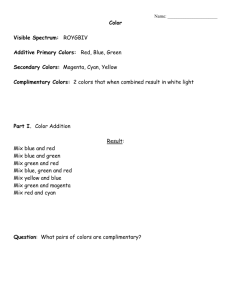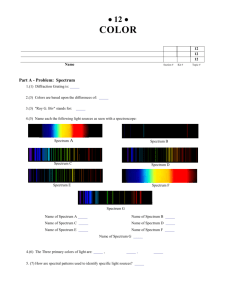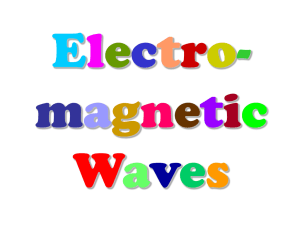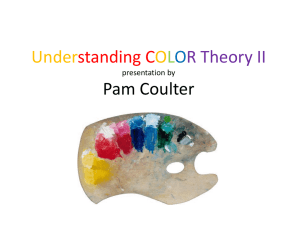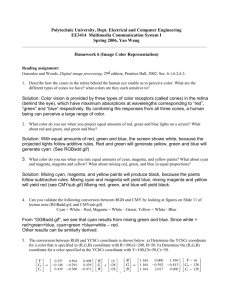PhysicsOfColor
advertisement
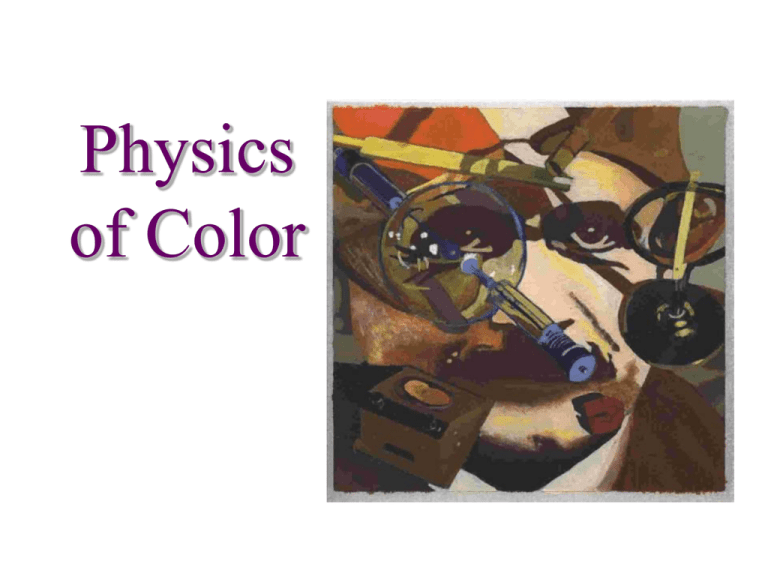
Physics of Color Spectrum of Visible Light Wavelengths & Photons Particles of light, called photons, each have a wavelength. Red Photon Yellow Photon Green Photon Blue Photon Prism Spectrum Newton’s Color Wheel Prism spectrum is a straight line, but Isaac Newton described color using a circular wheel Trichromatic Theorists Thomas Young (1773-1829) English physicist Hermann von Helmholtz (1821-1894) German physicist James Clerk Maxwell (1831-1879) Scottish physicist Additive Color Wheel R M Y B G C Spectral Colors Red Yellow Green Cyan Blue Magenta Hue, Saturation, Value Color wheel is not a single wheel but stack of wheels that range in value. Color Vision in the Eye Three types of cones (color) One type of rod (B/W only) Color Blindness Weakness or absence of one of the three types of cones is the cause of color blindness, leading to a reduced ability to distinguish colors. 29 or 70? 21 or 74? Incidence (%) Classification Males Females Anomalous Trichromacy 6.3 0.37 Protanomaly (Red-cone weak) 1.3 0.02 Deuteranomaly (Green-cone weak) 5.0 0.35 Tritanomaly (Blue-cone weak) 0.0001 0.0001 Dichromacy 2.4 0.03 Protanopia (Red-cone absent) 1.3 0.02 Deuteranopia (Green-cone absent) 1.2 0.01 Tritanopia (Blue-cone absent) 0.001 0.03 Rod Monochromacy (no cones) 0.00001 0.00001 CIE color “wheel” Cone Sensitivity Why Yellow & Orange are Special Green Red Blue Wavelength Peak sensitivities of green and red cone are close together, so we easily separate colors in this range, probably to spot ripe fruit and … Hot Sauce!!! Seeing Yellow Sodium lamps emit pure yellow photons Color monitor can only emit red, green, and blue (RGB); creates other colors by selectively turning RGB pixels on or off. circles overlapping and indicate the areas producing the primary and secondary colours. MAGENTA BLUE RED YELLOW CYAN WHITE GREEN http://lectureonline.cl.msu.edu/~mmp/applist/RGBColor/c.htm Adding Color Lights Stream of red & green photons looks same as yellow photons (metamerism) or Theatrical lighting Eye to Brain Notice overlap of red, green, & blue is seen as white light How does one get a complimentary color? • Give some examples. • - mix any two primary colors which becomes a complimentary color to the remaining primary color • - e.g. yellow (redprimary + greenprimary) is complimentary to blueprimary Yellow and blue would make white light Additive Color Mixing • Colors can be created by adding colors. • e.g. red and green = yellow • (2 primary colors = secondary color) • e.g. red and blue = magenta Review-Color • • • • • • • Visible light is made up of: Wavelengths of the electromagnetic spectrum from = 400 nm (4.00 x 10–7 m)to = 700 nm (7.00 x 10–7 m) Newton called the ordered arrangement of colors from violet to red a spectrum. A spectrum can be produced by passing a light beam through a prism. White light can be produced by adding the colors, red, green and blue which are also known as the primary colors. Secondary colors are formed by: mixing any two of the primary colors Secondary colors include yellow, cyan and magenta. The main spectral Colors red orange yellow green blue indigo violet R • • • • • O Y Goes Bowling Venezuela In lowest frequency highest frequency longest wavelength shortest wavelength least refracted most refracted lowest energy highest energy We see a specific color because we see a particular frequency. • Think of frequency as the number of crests per second hitting the retina of your eye. • So, if 4.29 x 1014 crests hit your retina in one second, then you see a visible part of the electromagnetic spectrum known as a color called red. The Color of Light and Refraction • When light waves pass from a less dense into a more dense medium, such as from air to water, the speed of the light wave decreases. • Yet, we see the same color under water as in air, therefore we still have 4.29 x 1014 crests hitting our retina per second. • This means that as the speed of the wave slows down, the wavelength gets shorter (crunched). • This way, the number of crests hitting the retina per second remains constant, ensuring that the color remains unchanged. Subtractive Process Subtractive Process Colors can be created by the subtractive process using filters. e.g. R O Y G B I V yellow filter We See Mostly Yellow Subtractive Process e.g. R O Y G B I V blue filter We See Mostly Blue Subtractive Process e.g. R O Y G blue filter red filter We See Black ( No Color) B I V Artist’s Handbook These spectral reflectance curves and those of many other standard pigments are found in Mayer’s book. Subtractive Process e.g. R O Y green filter yellow filter We See MostlyYellow G B I V Why Paint a Color Grid? “The results of mixing colored paints are sufficiently complicated so that no fully reliable theory has yet been developed. For the artist, there is no choice but to be fully familiar with the mixing properties of the paints on the palette.” Light and Color in Nature and Art S. Williamson and H. Cummins Mixing Blue & Red Paint Mixing paint or ink is different from adding colors together by light. Mix of blue and red paint produces a blackish brown Spectral Reflectance Curves When white light shines on a colored object, some photons absorbed, others reflected by the object’s surface. Name That Pigment 100% 0% BLUE GREEN Titanium White RED BLUE GREEN Cadmium Red RED BLUE GREEN Burnt Sienna RED Name That Pigment 100% 0% BLUE GREEN RED Phthalocyanine Green BLUE GREEN Cadmium Yellow RED BLUE GREEN Cobalt Blue RED Reflectance of Pigment Mixtures 100% 80% BLUE GREEN RED Take a mixture of equal parts cadmium red and cobalt blue. The mixture reflectance profile is defined as the geometric mean (square root of the product) of their separate reflectances for every wavelength in the spectrum. Cadmium Red 60% 40% Cobalt Blue 20% Mixture 400 500 600 Nanometers 700 For example, if cobalt blue reflects 20% of a specific blue wavelength (say 500nm), and cadmium red reflects only 5%, then their mixture will reflect roughly 10% of the 500nm light. (The product 20% x 5% = 100%, the square root of 100% is 10%.) NOTE: This only gives approximate results; full theory more complex! Pigments are opaque (not transparent) paints or inks placed onto opaque surfaces. These pigments absorb and reflect different amounts of color from white light. Most of the colored objects we see on earth are made up of combinations of reflected wavelengths. Surfaces or objects illuminated by white light absorb differing proportions of visible wavelengths and reflect the remainder. The principle of reflected color is illustrated in the following series of graphics: • a. Sunlight, as described above, is composed of equal amounts of all spectral hues (i.e., the colors of the rainbow). When sunlight, or artificial white light is shone on an opaque surface, certain wavelengths of light (colors) will be reflected off the surface while others will be absorbed by the surface. The "color" we see depends on the type and amount of reflectance of the wavelengths we identify as the spectral hues. White, as shown here, is created by the equal, full-strength (100%) reflectance of all three main spectral hues, that is 100% reflectance of blue, green and red. b. Medium Grey results from the 50% absorption, 50% reflectance of blue, green and red. Darker grey happens when more than 50% of each primary color is being absorbed and less is reflected. Light grey results when more than 50% of each primary color is being reflected and less is absorbed. c. Black is the absence of color, or the absence of reflected light, thus the total (100%) absorption of all three primary colors. d. Other colors can be created by the combined reflectance of certain of the spectral hues. A full strength cyan, for example, is comprised of 100% reflectance of blue and green, and 100% absorption of magenta. A medium strength cyan would result from 50% reflectance of blue and green. More or less than 50% reflectance of blue and green would form darker or lighter cyan, respectively. Note that there must be equal reflectance of blue and green in order for a true cyan to be formed. If more blue were reflected, the resulting color would be blue-green. If more green were reflected, the resulting color would be green-blue. e. Magenta (full strength) is formed by the equal reflectance of blue and red. Thus 100% reflectance of blue and red, and 100% absorption of green, forms a full strength magenta. f. As with cyan and magenta, a full strength yellow is formed by the equal (100%) reflectance of red and green, and 100% absorption of blue. Pigment Color Wheel http://lectureonline.cl.msu.edu/~mmp/applist/CYMColor/c.htm Red Green Blue • The Subtractive Primary Colors, created by the mixing of the Additive Primary Colors, are Cyan, Magenta, Yellow, and also Black, as shown here • Note that the subtractive primaries are those formed by the mixture of additive primaries. This is how paints and inks are mixed and used in painting and printing onto opaque surfaces. Note that the Subtractive Primary Colors mix to recreate the additive primaries: • • • • Magenta + Cyan = Blue Cyan + Yellow = Green Yellow + Magenta = Red Cyan + Magenta + Yellow = Black (absence of color) Examples for the Subtractive primaries are shown below: • Red (Magenta + Yellow) = White minus Green (Yellow + Cyan), minus Blue (Magenta + Cyan); in other words, Cyan is subtracted from both Green and Blue, leaving Yellow and Magenta which, when mixed, forms Red. Another way to look at it is that Green and Blue are subtracted from White, leaving only Red. • Blue (M + C) = White - Green (Y + C) - Red (M + Y); the subtraction of Yellow from both Green and Red leaves M + C which mixes to form Blue. • Green (Y + C) = White - Red (M + Y) - Blue (M + C) subtract magenta from both, leaves Y + C which together forms Green. • Black = White - Red - Blue - Green (absence of color) • Transparency example 4 color printing process How Polarizing filters work How Polarizing filters work only transverse waves can be polarized. - only perpendicular transverse waves are cancelled Malus’s Law http://www.colorado.edu/physics/2000/polarization/polarizationI.html Fun with Colors and messing with your brain • • • How anaglyph works Viewing anaglyphs through appropriately colored glasses results in each eye seeing a slightly different picture. In a red-blue anaglyph, for instance, the eye covered by the red filter sees the red parts of the image as "white", and the blue parts as "black" (with the brain providing some adaption for color); the eye covered by the blue filter perceives the opposite effect. True white or true black areas are perceived the same by each eye. The brain blends together the image it receives from each eye, and interprets the differences as being the result of different distances. This creates a normal stereograph image without requiring the viewer to cross his or her eyes. http://www.jessemazer.com/3Dphotos.html More Fun • http://dogfeathers.com/java/spirals.html • http://www.qualitytrading.com/illusions/ Negative After-image Stare, unfocused, at the red cross for 10 seconds then look at white wall Negative After-image Cyan Negative After-image Stare, unfocused, at the flag for 10 seconds then look at white wall Negative After-image Cyan Magenta Yellow Simultaneous Contrast Does the gray bar look slightly bluish? Are the two gray bars the same shade of gray? Yes, the presence of a nearby color affects perception of both hue and value, shifting both towards complement

